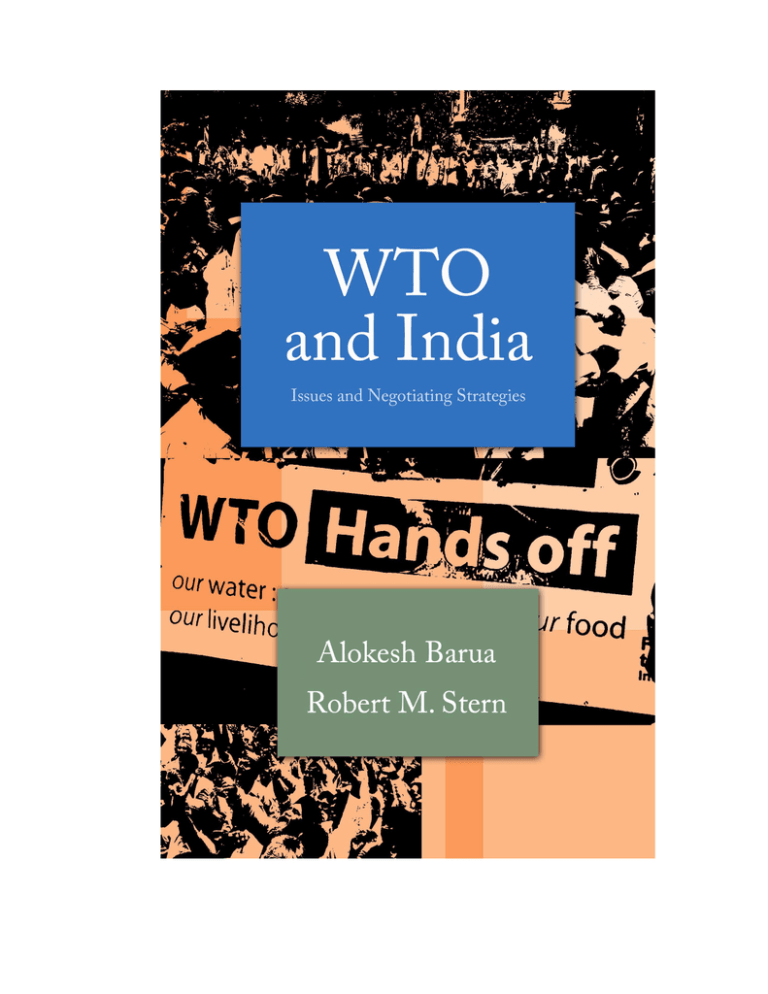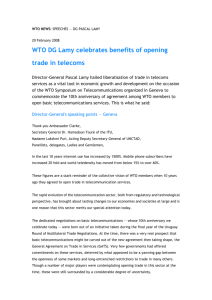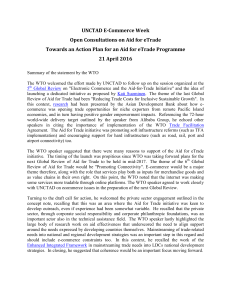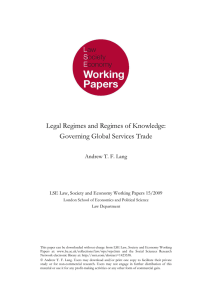Document 11623142
advertisement

India and the WTO: Issues and Negotiating Strategies Alokesh Barua and Robert M. Stern, Editors New Delhi: The Orient Longman, 2010 About the Book This book serves two purposes. It provides a straightforward exposition of the complex issues pertaining to the WTO agreements and negotiations, and it presents rigorous analyses of the impact of the WTO‐induced reforms on the Indian economy. The book addresses a number of salient issues, including: why trade liberalization might be beneficial for both developed and developing countries and in their long‐run economic interests; what India’s interests are in a multilateral forum like the WTO and how best India could utilize this forum to realize maximum advantage; whether India has a clear cut and well‐defined set of negotiating strategies; how the economic reforms have affected different segments of the economy since the inception of the WTO in 1995; whether the reform measures conform to India’s long‐term economic interests; whether the benefits from the WTO‐induced reforms are fairly and evenly distributed across the regions and across the population; and whether there is evidence to support that economic reforms have led to a decrease in income inequality and poverty in India. Our hope accordingly is that this book will contribute towards the understanding of the causality between the actual economic events and the WTO induced reforms. The WTO and India: Issues and Negotiating Strategies CONTENTS Page Abbreviation and short explanations of terms i­xii International Standards of measurement xiii Acknowledgement xiv­xvi 1. Introduction Alokesh Barua and Robert M Stern 1‐23 Section I: A Developing Countries Perspective 2. The WTO and Trade Negotiations: A Developing Country Viewpoint Manoj Pan 24‐63 3. The WTO and our Role in the World Economy of the Future Ashok Guha 37-40 Section II: Negotiating Options and Strategies 4. India and Coalitions in Multilateral Trade Negotiations Manmohan Agarwal 41‐57 5. Searching for the Missing Link: India's 'Negotiation Strategy' at WTO? Debashis Chakraborty 58‐69 6. Designing a Pro­active Stance for India in the Doha Development Agenda Negotiations Alan V Deardorff and Robert M Stern 70‐79 7. India at Doha: Retrospect and Prospect Arvind Panagariya 80‐102 Section III: Market Access: Agriculture, Manufactures and Textiles 8. WTO Agriculture Negotiations and India Ramesh Chand 103‐120 9. 10. 11. Trade and Industrial Performance Since the WTO Reforms: What Indian Evidences Suggest? Alokesh Barua, Debashis Chakraborty and Pavel Chakraborty 121‐144 How Big is the Bang for India? Market Access in Textiles Samar Verma 145‐168 Section IV: Trade Facilitation and Government Procurement Regional Integration through Trade Facilitation: Integrating East India with Bangladesh and North India with Central Asia Pritam Banerjee, Dipankar Sengupta and Phunchok Stobdan 169‐195 12. 13. 14. 15. Transparency in Government Procurement: A Case Study of India Sandwip Kumar Das 196‐213 Section V: TRIPS and GATS The TRIPS Agreement: Public Health Concerns for India Amit S Ray 214‐227 GATS and India: Negotiations in Mode 3 Rashmi Banga 228‐249 GATS Negotiations in Environmental Services: A developing country perspective with special reference to India Aparna Sawhney 250-263 Section VI: Growth, Poverty and Inequality 16. 17. Trade and Poverty in the Poor Countries Jagdish Bhagwati and T. N. Srinivasan 264‐268 Globalization, Growth and the Poor T. N. Srinivasan and Jessica Seddon wallack 269‐285 18. Income Distribution, Structural Change and International Trade: A Developing Countries Perspective with Special Reference to India Ananya Ghosh Dastidar 19. Trade Liberalization and Income Inequality: An Analysis of Inter­Regional Income Inequality in India Alokesh Barua and Pavel Chakraborty Complete Bibliography Contributors 286-313 314-336 337-359 360-362




